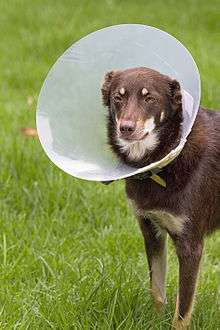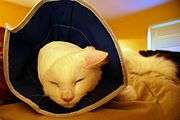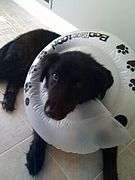Elizabethan collar

An Elizabethan collar, E-Collar, Buster collar or pet cone, (sometimes humorously called a pet lamp-shade, pet radar dish, dog-saver, or cone of shame) is a protective medical device worn by an animal, usually a cat or dog. Shaped like a truncated cone, its purpose is to prevent the animal from biting or licking at its body or scratching at its head or neck while wounds or injuries heal.[1]
The device is generally attached to the pet's usual collar with strings or tabs passed through holes punched in the sides of the plastic. The neck of the collar should be short enough to let the animal eat and drink. Although most pets adjust to them quite well, others will not eat or drink with the collar in place and the collar is temporarily removed for meals.[2]
While purpose-made collars can be purchased from veterinarians or pet stores, they can also be made from plastic and cardboard or by using plastic flowerpots, wastebaskets, buckets or lampshades. Modern collars might involve soft fabric trim along the edges to increase comfort and velcro surfaces for ease of attachment and removal.
The collars are named from the ruffs worn in Elizabethan times. A U.S. patent was filed by Frank L. Johnson in 1959.[3]
The 2009 animated film Up coined the colloquial name "cone of shame" for the collars, which feature as a minor plot point.
Types of collars




See also
| Wikimedia Commons has media related to Elizabethan collars. |
References
- ↑ "Espacenet - Bibliographic data". worldwide.espacenet.com. Retrieved 2018-09-19.
- ↑ "Dog Wound Care". www.doctordog.com. Retrieved 2018-09-19.
- ↑ US 3036554A, Frank L. Johnson, "Protective devices for dogs", issued 1959-02-24